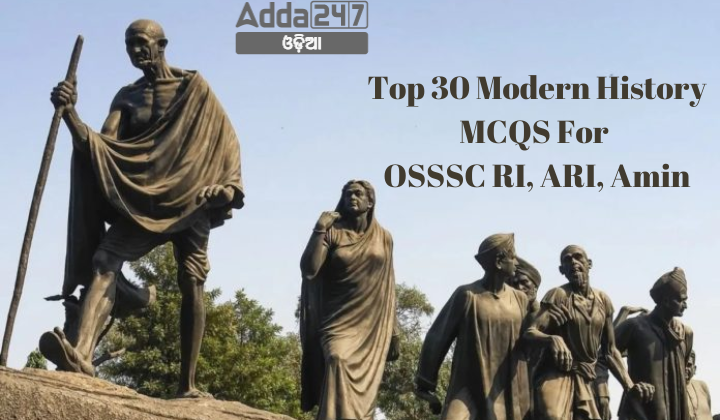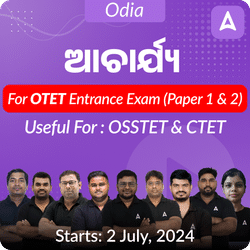Preparing for competitive exams such as OSSSC RI (Revenue Inspector), ARI (Assistant Revenue Inspector), Amin, SFS, or ICDS Supervisor often requires a strong grasp of historical events. Modern history, especially, forms a significant part of the syllabus, covering crucial periods and events that shaped the world as we know it today. To aid in your preparation, here are 30 multiple-choice questions (MCQs) focusing on modern history:
Top 30 Modern History MCQs for OSSSC RI,ARI, Amin, SFS, ICDS Supervisor
- Which major Maratha chief was diplomatically pressured to stay away from the war against the British during the Third Anglo-Maratha War?
(a) Peshwa Bajirao II
(b) Malharrao Holkar
(c) Mudhoji II Bhonsle
(d) Daulat Rao Shinde
Ans. (d) Daulat Rao Shinde - What was the main reason for the conflict between the British and the Marathas that led to the Third Anglo-Maratha War?
(a) British interference in Maratha internal matters
(b) Marathas’ attempt to retake their old possessions
(c) British conflict with the Pindaris
(d) Marathas’ desire to rebuild their old prestige
Ans. (c) British conflict with the Pindaris - What was the outcome for Peshwa Bajirao II after the Third Anglo-Maratha War?
(a) He was killed in battle
(b) He surrendered and was pensioned off to Bithur
(c) He continued to rule as a British ally
(d) He was exiled to Burma
Ans. (b) He surrendered and was pensioned off to Bithur - Which treaty was signed in 1817 between the British and Shinde, resulting in the British gaining control over Rajasthan?
(a) Treaty of Salbai
(b) Treaty of Bassein
(c) Treaty of Gwalior
(d) Treaty of Mandasor
Ans. (c) Treaty of Gwalior - What was the significance of the Third Anglo-Maratha War for the British?
(a) It led to the fall of the Mughal Empire
(b) It established British control over the Punjab
(c) It marked the end of the Maratha Empire and established British dominance over most of India
(d) It resulted in British control over the entire Indian subcontinent
Ans. (c) It marked the end of the Maratha Empire and established British dominance over most of India - Which body was created to handle political matters under the dual system of control?
(a) Court of Directors
(b) Board of Control
(c) Governor-General’s Council
(d) British Crown
Ans. (b) Board of Control - Who among the following was NOT a member of the Board of Control?
(a) Secretary of State
(b) Chancellor of the Exchequer
(c) Commander-in-Chief of the British Crown’s army in India
(d) Four Privy Councillors
Ans. (c) Commander-in-Chief of the British Crown’s army in India - What was a significant feature of the act concerning the Presidencies of Madras and Bombay?
(a) They were given independence from Bengal
(b) They became subordinate to the Bengal Presidency
(c) They were merged into a single presidency
(d) They were transferred under the Court of Directors
Ans. (b) They became subordinate to the Bengal Presidency - What did the act require of all civil and military officers within two months of their joining?
(a) To undergo military training
(b) To disclose their property in India and Britain
(c) To swear allegiance to the British Crown
(d) To travel to the British Parliament
Ans. (b) To disclose their property in India and Britain - Which term was used for the first time in this act?
(a) East India Company’s Territories
(b) Indian Subcontinent
(c) British Possessions in India
(d) Imperial Territories of India
Ans. (c) British Possessions in India - Before the British advent in Bengal, who collected revenue from the land on behalf of the Mughal Emperor or his representative, the Diwan?
(a) Farmers
(b) Zamindars
(c) Merchants
(d) Soldiers
Ans. (b) Zamindars - Which battle led to the East India Company being granted the Diwani of Bengal?
(a) Battle of Plassey
(b) Battle of Buxar
(c) Battle of Panipat
(d) Battle of Seringapatam
Ans. (b) Battle of Buxar - Who proposed the Permanent Settlement system in 1786?
(a) Warren Hastings
(b) Robert Clive
(c) Lord Cornwallis
(d) William Pitt
Ans. (c) Lord Cornwallis - When did the Permanent Settlement come into effect?
(a) 1786
(b) 1790
(c) 1793
(d) 1800
Ans. (c) 1793 - What was the fixed portion of revenue for the government under the Permanent Settlement?
(a) 1/11th
(b) 5/11th
(c) 9/11th
(d) 10/11th
Ans. (d) 10/11th - What document was the Zamindar required to give the tenant under the Permanent Settlement?
(a) Patta
(b) Firman
(c) Sanad
(d) Rukka
Ans. (a) Patta - Which British PM directed Lord Cornwallis to propose the Permanent Settlement?
(a) William Pitt
(b) Robert Walpole
(c) Charles Grey
(d) Benjamin Disraeli
Ans. (a) William Pitt - What was one of the main merits of the Permanent Settlement system?
(a) Increased revenue for the farmers
(b) Security for all parties involved
(c) Abolition of Zamindari system
(d) Reduction in taxes
Ans. (b) Security for all parties involved - What was a major demerit of the Permanent Settlement?
(a) It reduced the revenue for the British
(b) It created a class of absentee landlords
(c) It encouraged widespread rebellion
(d) It significantly improved agricultural practices
Ans. (b) It created a class of absentee landlords - What happened to the Zamindar’s rights if they failed to pay the fixed revenue on time?
(a) Their lands were confiscated
(b) They were imprisoned
(c) They were given a grace period
(d) Their lands were auctioned off
Ans. (d) Their lands were auctioned off - After the Battles of Plassey and Buxar, who had the real power in Bengal?
(a) The Nawab
(b) The British East India Company
(c) The local farmers
(d) The Mughal Emperor
Ans. (b) The British East India Company - What was the primary interest of the British East India Company in Bengal?
(a) Improving the plight of local farmers
(b) Maximising revenue and profits
(c) Establishing educational institutions
(d) Promoting local industries
Ans. (b) Maximising revenue and profits - Prior to the company’s rule, what was the tax rate on land revenue in Bengal?
(a) 50% of the agricultural produce
(b) 1/10th of the agricultural produce
(c) 1/3rd of the agricultural produce
(d) 75% of the agricultural produce
Ans. (b) 1/10th of the agricultural produce - What was one significant change in agricultural practices enforced by the British on Bengali farmers?
(a) Increased cultivation of food crops like paddy
(b) Harvesting of cash crops like poppy and indigo
(c) Increased storage of grain for lean seasons
(d) Implementation of modern farming techniques
Ans. (b) Harvesting of cash crops like poppy and indigo - What was the main cause of the Bengal Famine of 1770?
(a) Natural disaster
(b) The company’s tax and revenue policies
(c) War
(d) Locust invasion
Ans. (b) The company’s tax and revenue policies - How many people were estimated to have died due to the Bengal Famine?
(a) 1 million
(b) 5 million
(c) 10 million
(d) 20 million
Ans. (c) 10 million - Which event was directly influenced by the East India Company’s financial policies and led to significant historical consequences?
(a) The Sepoy Mutiny
(b) The Boston Tea Party
(c) The Opium War
(d) The Salt March
Ans. (b) The Boston Tea Party - How did the Bengal Famine impact agricultural lands in Bengal?
(a) Increased agricultural productivity
(b) Depopulated large swathes of land
(c) Reduced tax rates
(d) Introduced irrigation systems
Ans. (b) Depopulated large swathes of land - What was one of the global consequences of the Bengal Famine?
(a) Increased food exports to Europe
(b) Growth in the East India Company’s profits
(c) Abolition of the East India Company
(d) Decline in European colonialism
Ans. (b) Growth in the East India Company’s profits - What legislative act did the British Parliament pass in response to the East India Company’s financial issues?
(a) The Salt Act
(b) The Regulating Act
(c) The Tea Act
(d) The Charter Act
Ans. (c) The Tea Act










